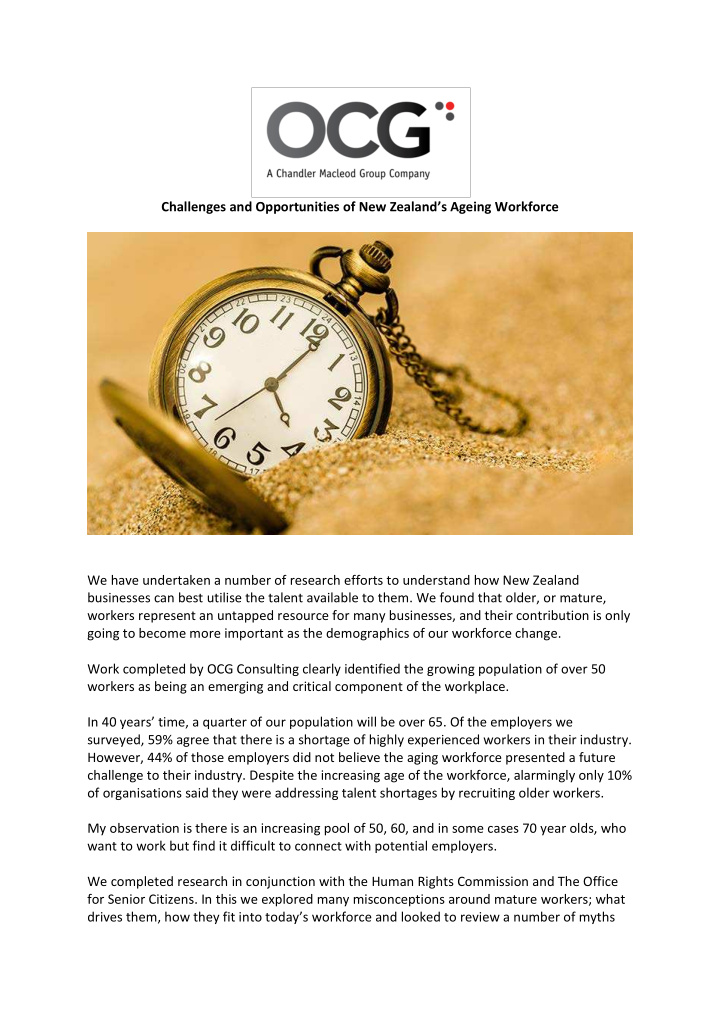



Challenges and Opportunities of New Zealand’s Ageing Workforce We have undertaken a number of research efforts to understand how New Zealand businesses can best utilise the talent available to them. We found that older, or mature, workers represent an untapped resource for many businesses, and their contribution is only going to become more important as the demographics of our workforce change. Work completed by OCG Consulting clearly identified the growing population of over 50 workers as being an emerging and critical component of the workplace. In 40 years’ time, a quarter of our population will be over 65. Of the employers we surveyed, 59% agree that there is a shortage of highly experienced workers in their industry. However, 44% of those employers did not believe the aging workforce presented a future challenge to their industry. Despite the increasing age of the workforce, alarmingly only 10% of organisations said they were addressing talent shortages by recruiting older workers. My observation is there is an increasing pool of 50, 60, and in some cases 70 year olds, who want to work but find it difficult to connect with potential employers. We completed research in conjunction with the Human Rights Commission and The Office for Senior Citizens. In this we explored many misconceptions around mature workers; what drives them, how they fit into today’s workforce and looked to review a number of myths
around them. For instance, they are less productive, can’t cope in a crisis, struggle with technology, are less motivated and don’t really need to work. Responses to our research actually showed most job seekers and employers believe the opposite of these to be true. • 81% of employers stated older workers are equally, or more, productive than younger workers • 59% of job seekers and 61% of employers believed that older workers were better in a crisis • 81% of older workers preferring a challenging and rewarding role instead of an easy transition into retirement • Only 10% of older workers stated they have no financial need for work. Technology literacy did stand out as a potential area to be addressed. 52% of employers and 43% of job seekers agreed with the notion that older workers struggle with technology. This establishes a call to action amongst employers and older workers to bridge this gap. Despite all the positive survey responses, older workers remain a relatively untouched talent pool. The reason behind this becomes more apparent when looking at the perceptions of age related discrimination. Although only 29% of employers feel age discrimination is a problem in their industry, 58% of older workers reported they have experienced age discrimination in the past five years. In addition 61% of all workers say they have witnessed it over that time period. The disparity between perception and experience indicates that age related bias is a problem, and needs to be addressed. These observations highlight a potential disconnect and suggest older workers are underutilised by many businesses, despite the more positive rhetoric. This is something that will need to change if businesses are to be properly prepared for the projected changes in workforce composition. Employers needed to avoid the potential for age bias. They should be proactive in helping line and hiring managers more effectively engage with older workers, consider different work patterns or different types of workplace contribution. Equally, while much is said about employer’s responsibility, there are also challenges for the older worker who may need to learn to adapt their careers to a changing workplace. The observation of a number of employers that older workers expectations, particularly around salary, were too high, suggest the older-worker may also need to re-calibrate linear career expectations and be mindful of different ways or patterns of working. With our customers we have also explored Flexible Work Design, Talent Management – the next wave and more recently the Rise of the Contingent Workforce. All of these efforts present insights into the role the ageing workforce will and can play in the future. The bottom line is that New Zealand businesses need to prepare for the impacts of an ageing workforce. With the demographics of the workforce shifting, the talent pool of older workers can be a great resource for many industries looking to address their talent
shortages. However, with certain myths still perpetuated, and age related discrimination prevalent in the workplace, employers may realise there are problems that need to be solved now, if they are to get the best out of the workforce in the future. If you’d like to read more of our research on the ageing workforce, click here for our full whitepaper on the topic.
Recommend
More recommend